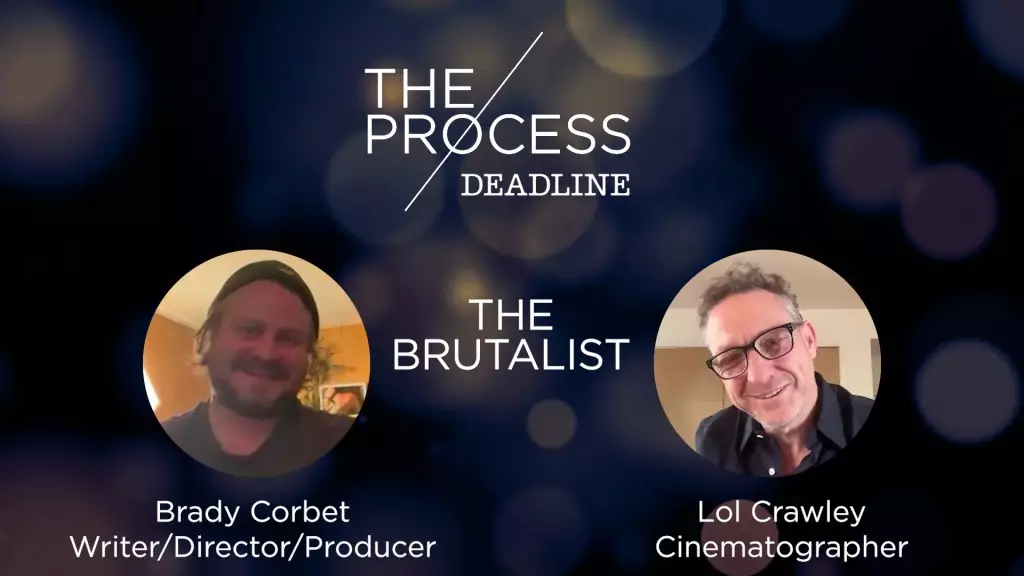In the realm of contemporary cinema, few collaborations have drawn as much intrigue as the partnership between director Brady Corbet and cinematographer Lol Crawley. With “The Brutalist,” they enter uncharted territory as their third joint endeavor, following the strikingly ambitious features “Vox Lux” and “The Childhood of a Leader.” This ongoing collaboration highlights an evolving creative dialogue, characterized by a shared vision that marries technical prowess with rich storytelling. As Corbet reflects on their collaborative dynamic, he emphasizes the inherent ambition that shapes their projects, which has often attracted polarized reactions. While some critics may label their works as excessively grandiose, others recognize the sincerity that underlines their artistic efforts.
Corbet’s insights reveal a duality intrinsic to filmmaking. He acknowledges the tension between the intimate narrative arc—focused closely on character—and the expansive, almost overwhelming scope that emerges during the production phase. For Corbet, the writing process is markedly introspective, confined to a “small world” that unfolds through its characters. Yet, as the project matures and various creative contributions coalesce—spanning from design to direction—the cinematic universe expands significantly. Corbet’s journey from trepidation to confidence is indicative of the broader filmmaking process, where the contributions of an entire team morph a diminutive vision into something grand and engaging.
Crafting Cinematic Language through Visual Poetics
Crawley’s perspective on their collaborative efforts underscores an awareness of the visual language that defines “The Brutalist.” When discussing the ambition behind their cinematic endeavors, he notes the importance of executing key scenes as single takes that encapsulate both motion and stillness. This emphasis is not merely technical; it speaks to a broader thematic exploration through spatial interaction and performance. “Cinematic” is a term often tossed about, but to Corbet and Crawley, it takes on a more profound meaning that intertwines narrative with the very essence of the filmic medium.
This approach challenges conventional storytelling methods, positioning the viewer within the frame while inviting them to engage with the characters’ emotional landscapes more intimately. It is a dance between the macro and the micro, where a grand vista is complemented by visceral performances, creating layers of meaning that resonate with audience members. In this light, “The Brutalist” aspires to craft not just a story, but an experience that transcends linear narratives, encouraging viewers to contemplate the very fabric of the human experience post-World War II.
Behind the polished final cut of any film lies the often tumultuous reality of the set environment. Corbet articulates an unvarnished truth about the filmmaking process: it is grueling and demanding, leading to sleepless nights and a frenetic pace that, frankly, can be unhealthy. Crawley’s observation about the outsider’s perception of a film set captures a distinct contrast; for those uninitiated, it may appear as an endless monotony interspersed with bursts of creativity. Yet for those within the bubble, the collective passion drives them, though the atmosphere may sometimes feel toxic and frenetic.
Corbet’s candid remarks touch upon the emotional toll of this collaborative venture. The excitement of creativity is often shadowed by the pressures that come with managing a large team of individuals, each with their unique stresses and frustrations. This juxtaposition reveals the often-glamorous façade of filmmaking obscures a more genuine struggle, highlighting the unwavering commitment required to bring a vision to fruition.
Set against the backdrop of post-war Europe, “The Brutalist” chronicles the poignant narrative of László Tóth, played by the talented Adrien Brody. A Hungarian-Jewish architect, Tóth’s journey unfolds as he grapples with his past while building a new life in America, awaiting the arrival of his wife, Erzsébiet. This storyline invites audiences into a deeply personal realm of loss, resilience, and hope.
With a weighty subject matter that explores both the darkness of history and the light of human spirit, the film has already begun garnering critical acclaim, including a Golden Globe for Best Motion Picture Drama. As it vies for numerous accolades, including ten Oscar nods and nine BAFTA nominations, “The Brutalist” stands not only as a testament to Corbet and Crawley’s ambitious artistry but also as a poignant reminder of cinema’s power to reflect and reshape narratives—both personal and collective.

